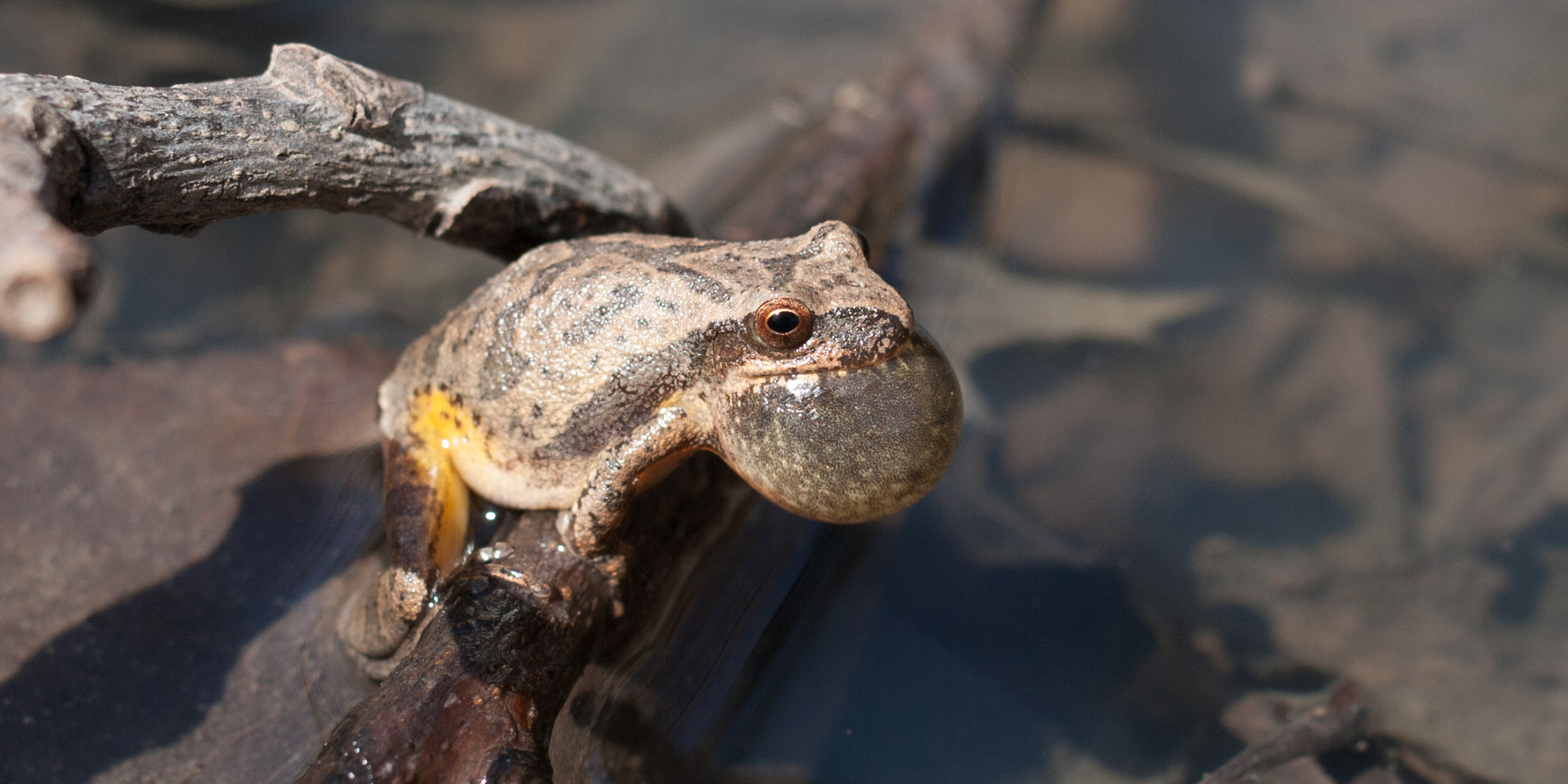Originally published 22 April 1991
The spring peepers are in full fortissimo chorus.
On Nantucket they call these noisy little frogs pinkletinks, presumably because that’s how Nantucketers hear the sound. I’m not sure how I’d describe the peeper’s call. Pinkletink doesn’t do justice to the volume. Not peep-peep either. The peeper’s voice is shrill and high pitched, and when the water meadow is in heady voice it’s like a zillion wedding guests clanking on glassware with spoons.
The peeper is only an inch long, but it’s all voice-box from stem to stern. Most frogs call by inflating air sacs under their chins; peepers inflate their whole bodies. The air is not expelled with each peep. The peeper uses its body like a bagpiper’s bag; keeps it pumped up for the duration of its amatory calls.
This year the chorus began on March 28. A week later I stood by the side of the water meadow and the whole place seemed to sing. You’d swear they were everywhere; a carpet of sound stretched away from my feet. But not a peeper to be seen. I scanned the water with binoculars. The weeds and the bushes. Not a sign of the elusive frogs. Pure, disembodied pandemonium. The water itself seemed to be emitting the noise.
Off with the shoes. Roll up the trousers. Into the water. Out to the very middle of the water meadow. Silence, as if someone has pulled the plug on the amplifier. I stand still as a statue. Five minutes, ten. Then, it starts up again, that ear-splitting carpet of sound. The peepers are still invisible.
Mating chorus
It’s the male frog making all the noise, and we know why. It’s that old spring business all over again: finding a mate. But why the tumultuous decibels? Why the din? Is the female peeper deaf? Does she choose a mate by the amplitude of his call? Has evolution cranked up the volume of this chorus by finding some connection between the loudness of the love song and reproductive fitness?
Or is it something else, something you won’t find in the biology books — pure excess vitality, a capacity of water and muck to make noise, to celebrate.
Of course I’m being facetious, but not altogether so. I’m talking about the astounding resiliency of life, its ability to survive the harshest conditions and to spring up in the unlikeliest places. The Roman naturalist Pliny the Elder wondered about all those frogs coming out of nowhere in the spring with their outrageous racket, and attributed it to an “occult operation” by nature. In other words, magic. Slight-of-hand. Hocus-pocus.
We are more hard-headed about it. We know the peepers have been there all along, buried in the mud throughout the long winter, just waiting for a couple of warm days to beckon them up into song. But what about life itself? What “occult operation” of nature conjured up life on the Earth nearly 4 billion years ago, out of water and muck? One minute the planet was lifeless (presumably), and the next minute (give or take a few tens of millions of years) the whole place was swimming with microbes — and it’s been swimming ever since.
Most biologists believe that life began spontaneously from non-living materials. Darwin imagined it happened in a “warm little pond” somewhere on the early Earth, the quietly simmering primeval soup so dear to generations of biologists. According to this theory, chemicals stewing in water formed themselves into proteins, RNA, DNA, and ultimately the first living cells.
Chaotic birth
But Darwin’s warm little pond may never have existed. Recently, planetary scientists have been telling us that Earth was a nasty place back at about the time life was starting. The surface of the planet was subject to rampant volcanism. Meteorites rained from the sky for hundreds of millions of years, the same incessant bombardment that pulverized the surface of the moon (on Earth the evidence of that early bombardment has been erased by erosion and tectonic activity). A few meteorites may have carried enough energy to completely vaporize the oceans.
It’s hard to imagine how or where in the midst of such chaos the complex and delicate structures of life were created and sustained. Perhaps it happened near volcanic fissures on the floors of the deepest oceans, even as the meteorites pelted down. Or perhaps in hot springs on continents as the bombardment waned.
Since no one knows how life began, I’ll opt for the theory that it was all more or less inevitable. Start with a hydrogen-rich environment, throw in some carbon, expose it to energy, and — presto! — you’ve got amino acids, phosphates, sugars, and organic bases, the chemical building blocks of life. Add cycles of heat and cold, dry and wet, light and darkness, maybe a catalyst like iron pyrites or clay, and any old planet with a reasonably moderate environment will pull the rabbit out of the hat. Or the peepers out of the pond.
I can’t prove it but I choose to believe that water and muck has a built-in tendency toward animation, and that life is ubiquitous, not only here but throughout the universe. I don’t mean to sound mystical, but if we’ve learned anything in the 20th century it is that matter, plain old matter, is subtle stuff, rich in possibilities of combination.
Just listen to that racket rising from the water meadow. That’s what the spring peepers’ hallelujah chorus is all about: the sheer, unstoppable ebullience of life.



